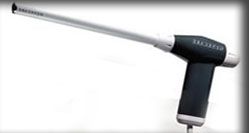 U.S. surgeons perform approximately 600,000 hysterectomies a year, making it the second most common female surgery. Traditional hysterectomy surgery is very invasive; the surgeon makes a 4-inch incision into the abdomen that results in a prolonged hospital stay and a slow and somewhat painful recovery.
U.S. surgeons perform approximately 600,000 hysterectomies a year, making it the second most common female surgery. Traditional hysterectomy surgery is very invasive; the surgeon makes a 4-inch incision into the abdomen that results in a prolonged hospital stay and a slow and somewhat painful recovery.
Enter laparoscopic power morcellation, supposedly the perfect minimally invasive medical technique to simplify hysterectomy surgery. Power morcellators have small blades that cut the uterus or uterine fibroids into tiny pieces so the surgeon can remove them laparoscopically. The technique promised patients a reduced post-operative recovery time with virtually no scarring. With this technologically-advanced option, what surgeon wouldn’t recommend using a power morcellator to perform a hysterectomy, and what woman wouldn’t choose a tiny incision over a four-inch scar?
Now, new research is giving surgeons and women alike good reason to opt against power morcellation. In April, the FDA released a press announcement discouraging the use of laparoscopic power morcellation for fibroid removal because of the risk that the device’s spinning blades can inadvertently spread cancerous tissue, usually uterine sarcomas, to the pelvis and abdomen. Then in July, the Journal of the American Medical Association reported on a Columbia University study that found that a staggering 1 in 368 women have undetected uterine cancer that may be spread by a power morcellator. This far exceeded the FDA’s previous risk analysis.
The revelation that power morcellators are likely spreading cancer in thousands of women has prompted the medical community to urge the FDA to completely ban the use of power morcellators for hysterectomies and myectomies. In response, Johnson & Johnson’s Ethicon division stopped selling morcellators and requested a voluntary recall of existing units. Two senators, Senators Chuck Schumer and Kirsten Gillibrand, also wrote a letter to the FDA asking it to “seriously consider” the new research and request that the other manufacturers of power morcellators pull them from the market. So far, Johnson & Johnson is the only manufacturer to heed the call.
With the risk of spreading life-threatening cancer to thousands of women, what are the other power morcellater manufacturers waiting for? Olympus Corp., Blue Endo, LiNA Medical, Karl Storz GmbH, and Richard Wolf GmbH refuse to comment on what action (or inaction) they are planning. In fact, the manufacturers’ websites still tout the power morcellators as: “not unhazardous” and “safer to use” (Richard Wolf GmbH); and “firmly established” (Karl Storz GmbH). LiNa Medical’s mission statement is to provide “innovative devices” that “improve clinical outcome[s]”, but that is an empty promise when it continues to sell a dangerous medical device. And while Blue Endo has added the FDA’s warning to its power morcellator product website, it states that all surgical procedures present risks to patients so patients should discuss their options with their doctors.
These companies should be held accountable for blatantly promoting the power morcellator as a safe, low-risk, medical device when the FDA and other reputable studies have concluded it poses serious cancer risks. A growing number of women who were diagnosed with uterine cancer after undergoing a hysterectomy using a power morcellator are starting to file morcellator cancer lawsuits against the manufacturers of these dangerous medical devices, and these numbers are sure to increase exponentially in the near future.
Our Virginia product injury attorneys have successfully pursued lawsuits on behalf of clients who were injured by dangerous and defective products, and we know that a manufacturer’s decision to value profits over consumer safety can be costly – financially and emotionally – for victims. For more information, see our firm’s answers to frequently asked questions about dangerous and defective products.
AM